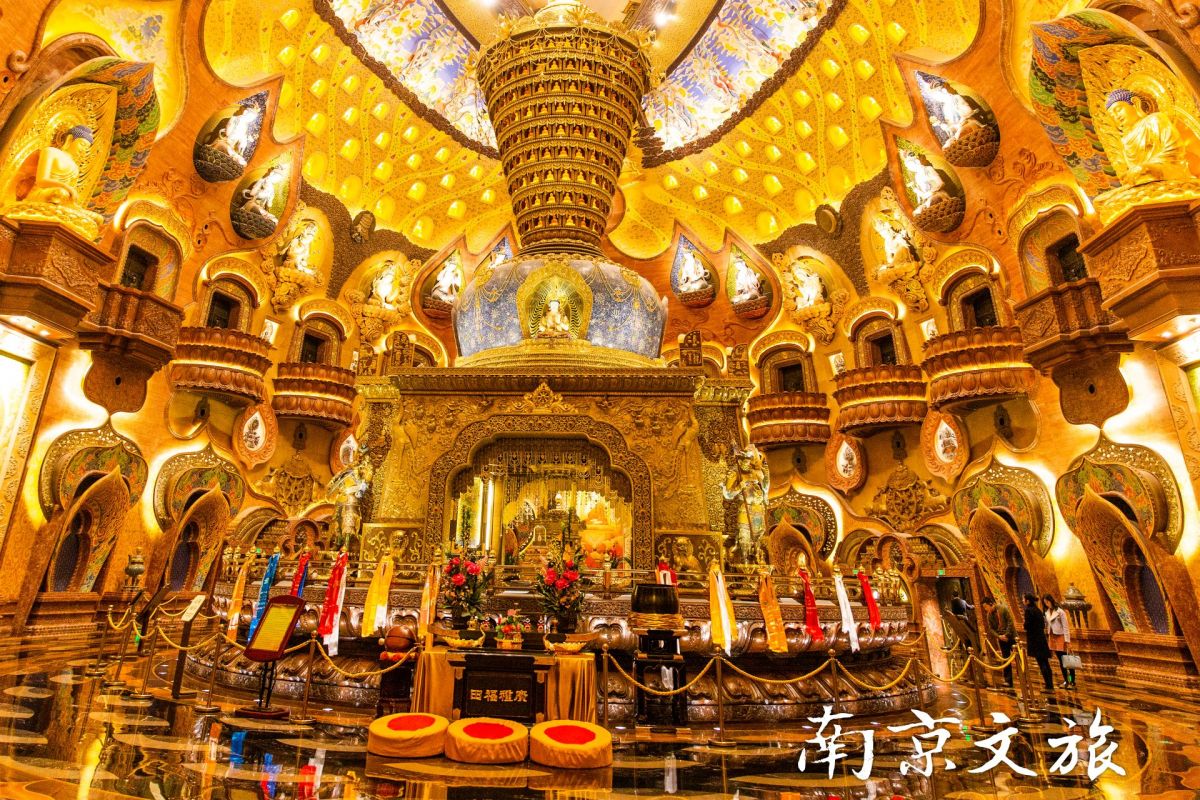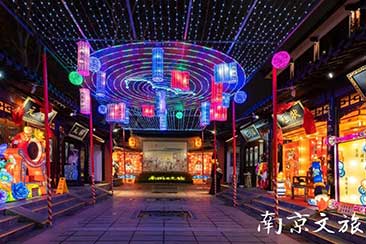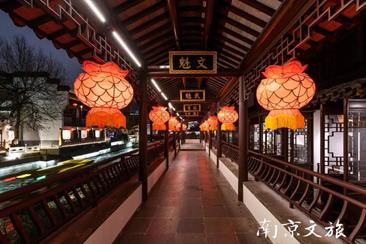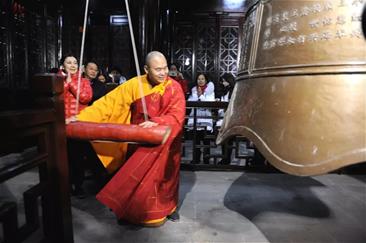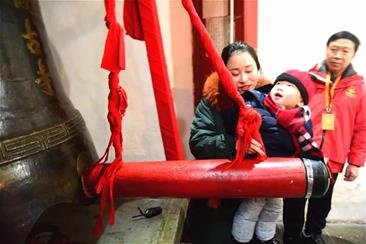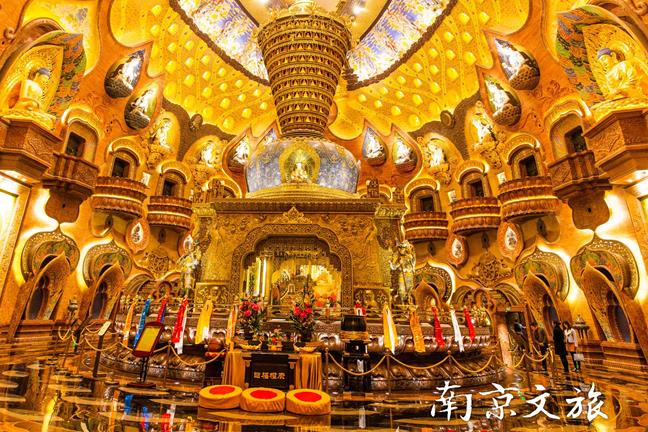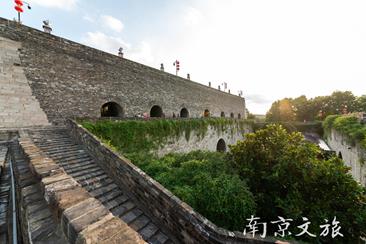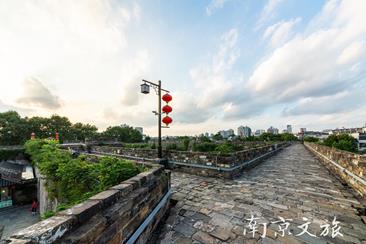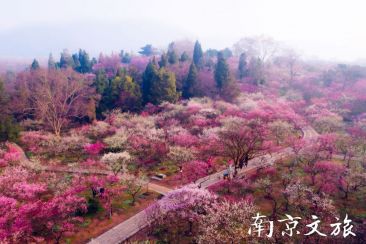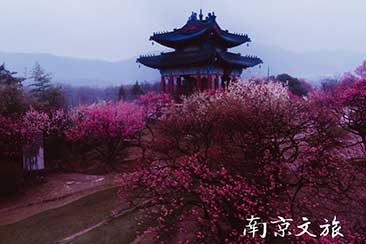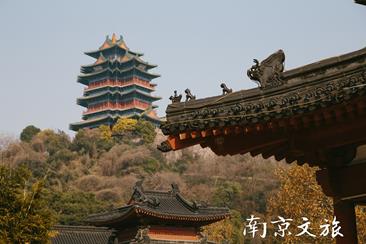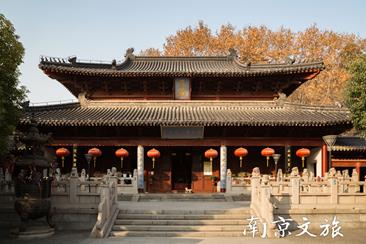Celebrations of the Chinese Traditional Festival in Nanjing in Winter
Winter is the festive season for Chinese family reunion and welcoming the New Year. The long and rich history and culture of Nanjing, titled “Ancient Capital for Six Dynasties”, have left it with the legacy of an abundance of excellent, unique and wonderful festivals and customs that attract tourists to have a touch of the traditional Chinese culture and explore Nanjing.
Representative winter festival celebrations in Nanjing:
| Festival Name | Recommended Site | Time |
| Qinhuai Lantern Festival | Recommended lantern festival exhibition areas: Fuzimiao (Confucius Temple) Qinhuai Scenic Area, Yu Garden (Hu's Garden), The Old South End - Mendong Historical and Cultural District | The first lunar month |
| New Year's Eve Bell Ringing | Qixia Temple, Jiming Temple | Chinese New Year's Eve |
| Public Worship of Buddha's Parietal-bone Relic | Niushou Mountain Cultural Tourism Zone | During the Spring Festival |
| Nanjing City Wall Climbing | Zhonghua Gate (formerly Jubao Gate) | The 16th day of the first lunar month |
| Nanjing International Plum Blossom Festival | Plum Blossom Hill | From late February to mid-March |
| Temple Fair of Goddess Mazu | Tianfei Temple | The 23rd day of the third lunar month |
Qinhuai Lantern Festival
The Qinhuai Lantern Festival, also known as the Jinling Lantern Festival and the Confucius Temple Lantern Festival, is a folk cultural event in Nanjing. It is an annual 50-day celebration during the period of Spring Festival and Lantern Festival. Recognized early as one of China's Intangible Cultural Heritage, the festival is reputed the best lantern festival or show in the world. It is the only large-scale, multi-purpose lantern show in China with lantern exhibition, fair and markets all wrapped into one, and is the folk lantern festival of the longest duration, biggest turnout and the largest scale in all of China.
The Qinhuai Lantern Festival is a must-see if you are in Nanjing during the Spring Festival. When the city shimmers under the wavering light from the lanterns, you will be too enchanted to leave.
Time: The first lunar month
Recommended places-to-go: Fuzimiao (Confucius Temple) Qinhuai Scenic Area, Yu Garden (Hu's Garden), The Old South End-Mendong Historical and Cultural District
Fuzimiao (Confucius Temple) Qinhuai Scenic Area
Address ofthe Tourist Center: No. 95 Gongyuan Street, Qinhuai District, Nanjing
Contact No.: +86 25 52209788
Metro lines:
- Take Metro Line 1 to the Sanshanjie Station (Exit 4). Turn right onto Jinshajing Road, and then walk along Zhonghua Road and Zhanyuan Road to get into the scenic area;
- Take Metro Line 3 to the Fuzimiao Station (Exit 3) and walk along Pingjiangfu Road. The scenic area is located 300 meters further on the left hand side.
Bus routes:
- Take Bus Line 14, 23, 43, 46, 63, 701, or 703 to the Changle Road stop. Walk 100 meters to the west and then walk along Laiyan Road to the north into the scenic area;
- Take Bus Line 1, 4, 7, 40, or 49 to the Fuzimiao stop. Walk into the scenic area;
- Take Nanjing City Tour Bus to the Zhanyuan Road stop and then walk there.
Yu Garden (Hu's Garden)
Address: No.1 Hu's Garden, Mingyang Street, Qinhuai District
Contact No.: +86 25 58361190
Bus routes:
- Take Bus Line 14, 19, 35, 62, 75, 81, 301, 313, or 317 to the Jiqingmen stop. Walk along Jiqing Road to the east onto Mingyang Street, and walk about 200 meters to the south;
- Take Nanjing City Tour Bus to the stop of Hu's Garden (Hujiahuayuna) and then walk there.
The Old South End-Mendong Historical and Cultural District
Address: Intersection of Gutong Lane and Jianzi Lane, Qinhuai District
Tourist Center: +86 25 58776699
Metro lines: Take Metro Line 3 to Wudingmen Station (Exit 2). Turn right and walk along Madao Street till the crossroad, turn to the south and you will see the Laomendong memorial archway.
Bus routes:
- Take Bus Line 46, 14, 706, 305, or 701 to the Gutongxiang stop. Walk 300 meters south into Laomendong;
- Take Bus Line 23, 33, 43, 63, 81, 87, 88, 703, 301, 304, or 305 to the Pipaxiang stop. Walk 50 meters west to Gutong Alley and walk south to Laomendong;
- Take Nanjing City Tour Bus to the Laomendong memorial archway.
New Year's Eve Bell Ringing
Buddhist's philosophy states the function of bell ringing as eliminating worries and bringing good fortune and peace.
Spring Festival is a traditional Chinese festival and an occasion for family reunions. During the festival, ringing temple bells to pray for blessings has become the most influential destination brand typical of New Year celebrations in Nanjing.
In a peaceful and festive atmosphere on New Year's Eve, friends and families ring temple bells after the countdown and chant mantras to pray for a better new year.
Photo Credit: Official Wechat account of Qixia Temple
- Time:Chinese New Year's Eve
- Recommended places-to-go: Qixia Temple, Jiming Temple
Qixia Temple
Address: Qixia Mountain Scenic Area, No. 88 Qixia Street, Qixia District
Contact No.: +86 25 85766979
Bus routes: Take Bus Line 138, 194, 206, 326, 327, or 332 to the Qixiasi stop (Qixia Temple)
Metro lines: Take Metro Line 1 to Nanjing Railway Station, change to Bus Line 206 at the North Square; or take Metro Line 2 to Xueze Road Station, and take Bus Line 138 to the scenic area.
Jiming Temple
Address: No.1 Jimingsi Road, Xuanwu District, Nanjing
Contact No.: +86 25 83361123
Metro lines: Take Metro Line 3 or Line 4 to Jiming Temple Station (Exit 5), and walk about 500 meters;
Bus routes: Take bus line 3, 31, or 52 to the stop of Beijing East Road/Jinxianghe Road; take Bus Line 11, 20, or 48 to the stop of Beijing East Road/Jiming Temple; or take Bus Line 304 to the Jimingsi stop (Jiming Temple).
Public Worship of Buddha's Parietal-bone Relic
Buddhism has a long reach in Nanjing. The only existing Sakyamuni Buddha's parietal-bone relic has long been enshrined in Niushou Mountain, Nanjing, and is open for public worship only on specific occasions each year.
During the Spring Festival, a series of blessing and folk activities such as bell ringing, sutra copying, and presenting flowers to the Buddha in Buddist rituals take place in the Niushou Mountain Cultural Tourism Zone. Tourists can take the opportunity to be part of the cultural event amid the Buddhist cultural atmosphere in Nanjing.
Dos and Don'ts for Worship
Prior to the worship, it is best to bathe and purify your body and mind before entering the temple to show your devotion to the Buddha; fasting is advisable before worshiping as meat, tobacco and alcohol are considered disrespect to the Buddha.
Neat and tidy dressing is preferred. Capping or improper dressing is not allowed during worshiping. Adults and children are not allowed to horse around in the main hall. Women should not enter the hall wearing revealing outfits
Notice: Please check the website for the specific time for the Public Worship of Buddha's Parietal-bone Relic at Niushou Mountain.
Address: Niushou Mountain Cultural Tourism Zone, No. 18 Ningdan Avenue, Jiangning District
Ticket: CNY 98/person
Contact No.: +86 400 165 6363
Bus routes: Take Bus Line G70, 754, or 755 to the stop of Niushaoshan Scenic Area East, or take Bus Line 712 to the stop of Niushaoshan Scenic Area (the east entrance); or take Bus Line 710 to the Zhoucun stop and walk to the west entrance of the scenic area.
Nanjing City Wall Climbing
Zhonghua Gate (formerly Jubao Gate)
Zhonghua Gate, originally called Jubao Gate during the Ming and Qing Dynasties, is also known as barbican because of its resemblance to earthenware jars. It was the south gate of the capital in Ming Dynasty, and is the largest gate among the city gates of Nanjing. There are 27 caves capable of accommodating up to 3,000 soldiers and conserving 5,000 quintals of grain. Having witnessing more than 600 years of vicissitudes, it still attracts tourists both at home and abroad with its profound historical charm and stunning ancient military architecture.
On the 16th day of the first lunar month, residents in Nanjing come to Zhonghua Gate with their families or friends to climb the city wall, an activity called “walking away from diseases” and “stepping on a peaceful path”. As the city gets warmer in the first lunar month, outing and fresh air can be refreshing and beneficial to health.
Time: The 16th day of the first lunar month
Address: Zhonghua Gate (Nanjing City Wall Zhonghua Gate Scenic Area), Qinhuai District
Contact No.: +86 25 86625435
Ticket price: CNY 50/person
Metro lines: Take Metro Line 1 to Zhonghua Gate or Sanshan Street Station and walk for about 1.3 km.
Bus routes: Take Bus Line 2, 16, 63, 202, 302, or 703 to the stop of Zhonghuamen Chengbao and then walk for about 150 meters.
Nanjing International Plum Blossom Festival
Plum blossom is the city flower of Nanjing. Cultivation of plum blossoms in Nanjing dates back over 1,500 years during the Six Dynasties. The best time to enjoy the pleasant fragrance at Plum Blossom Hill is February when one of the liveliest festivals in Nanjing, the Nanjing International Plum Blossom Festival, takes place.
Located in the Xiaoling Tomb of the Ming Dynasty Scenic Area, Plum Blossom Hill is well-known as the “Top One Plum Blossom Hill in the World” and is the main venue of the Nanjing International Plum Blossom Festival (held every year from February to March). The Festival is accompanied by festive activities, including exhibition of plum blossom paintings and calligraphy, music and dance performances, lectures on plum blossom culture, and garden tours.
Every year, it offers tourists an opportunity to appreciate the unique beauty. Thousands of tourists flock to Plum Blossom Hill for admiring the blooming flowers and scenery. What a spectacular sea of fragrant flowers and people!
Time: From late February to mid-March
Address: Xiaoling Tomb of the Ming Dynasty Scenic Area, Zhongshan Mountain National Park, Xuanwu District, Nanjing
Ticket: CNY 70/person (ticket for Xiaoling Tomb of the Ming Dynasty Scenic Area is required)
Opening hours: 06:30-18:00 (November - February), 06:30-18:30 (March - October)
Traffic:
- Metro Line 2/Muxuyuan Station Exit 1
- City Tour Bus/Mingxiaoling Stop (Plum Blossom Valley Parking Lot)
- Take bus line 20 or 315 to the Mingxiaoling Stop
Contact No.:
- Hotline: +86 25 84431174
- Ticket: +86 25 84437786
- Helpline: +86 25 84442880
Temple Fair of Goddess Mazu
Temple Fair of Goddess Mazu is a traditional folk event that integrates folk art, religious beliefs and cultural arts. It is a celebration at Tianfei Temple in Yuejiang Tower Scenic Area dedicated to Mazu's birthday - the 23rd day of the third lunar month. The general public will worship the goddess and pray for peace on the grounds in front of Tianfei Temple and Jinghai Temple. The Fair is not to be missed if you want to truly feel the culture of goddess Mazu in Nanjing.
Time: The 23rd day of the third lunar month
Address: Yuejiang Tower Scenic Area (Tianfei Temple and Jinghai Temple), No. 202 Jianning Road, Gulou District
Ticket: CNY 40/person
Opening hours: 8:30-17:30 (no entry after 17:00)
Hotline: +86 25 58590292
Traffic:
- Take Bus Line 539, 21, 54, 10, or Y10 to the Xingzhongmen stop. Walk 230 meters to the south entrance to Yuejiang Tower;
- Take Bus Line 12, 550, Y38, or Y42 to the Daqiaofandian stop. Walk 470 meters to the south entrance to Yuejiang Tower;
- Take Bus Line 100 or 531 to the Yijiangmen stop. Walk 750 meters to the south entrance to Yuejiang Tower;
- Take Bus Line 16, Y16, 39, Y3, or Y18 to the Nanjingxi stop. Walk 790 meters to the south entrance to Yuejiang Tower.

